Several weeks ago, Ros Clarke, a reader here on Needle ‘n Thread, dropped me a line to let me know she’d be taking a class at the Royal School of Needlework. She offered to write up her experience for us – kind of an insider’s scoop.
I thought that sounded like fun! After all, who doesn’t like an insider’s scoop?
So I’m going to turn you over to Ros and let her chat with you about her recent RSN visit and class. I hope you enjoy it!

I’ve been embroidering on and off for over thirty years, but I’m mostly self-taught and although I’m not a beginner I definitely have a lot of areas where I could improve.
I’ve taken a couple of day classes over the years, including some at the Royal School of Needlework, which have been consistently excellent.
This week I was on a two-day class there, Screen Printing with Surface Embroidery, taught by Jen Goodwin. Jen did her apprenticeship at the RSN and is a regular tutor there. She was also involved in embroidering Kate Middleton’s wedding dress!
The RSN runs day classes in a few locations around the UK and, I believe, some in the US. But my course was at the RSN headquarters in Hampton Court Palace, which is obviously the coolest place to study.
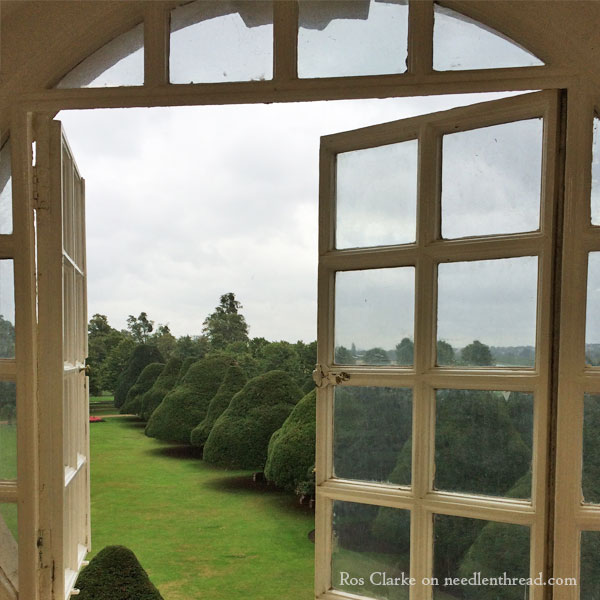
The classroom was up the back stairs in what must have been servants’ quarters. But it had lots of light and beautiful views. It’s a wonderful place to stitch.
There were 7 students in the class, which gave us all plenty of time for individual attention, and we enjoyed our time learning together.
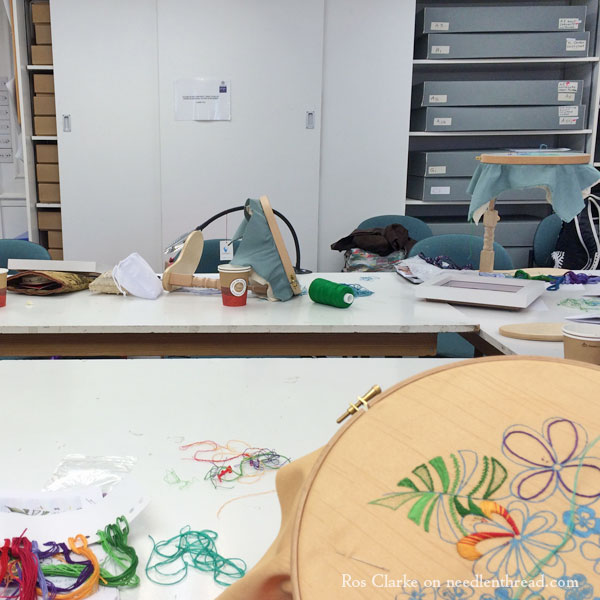
The other fun thing about doing the classes at Hampton Court is that the RSN shop is there. I bought a couple of magazines, a seat frame with hoop, and Trish Burr’s book on colour which looks amazing. The security pass you get while you’re doing the course allows you entry into the palace, so I took a couple of hours after class to visit my favourite rooms and was rewarded by coming across a group of fabric conservators working on William III’s bed. All the covers were laid out, with the three layers of mattresses and pillows, and samples that you could touch to get a sense of how it was all put together. So cool!
Anyway, back to the embroidery. We began with the screen printing. Jen uses this technique for transferring designs onto fabric for her embroidery kits. The designs we were working with are intended to have some of the printing visible – you can stitch as much or as little as you like.
We had three different designs to choose from, and everyone picked their background fabric and ink colour. I love bright colours so I picked a yellow background and teal blue ink. The ink has a beautiful pearlescent sheen which works really well with the dupioni fabric and the sheen of the embroidery.
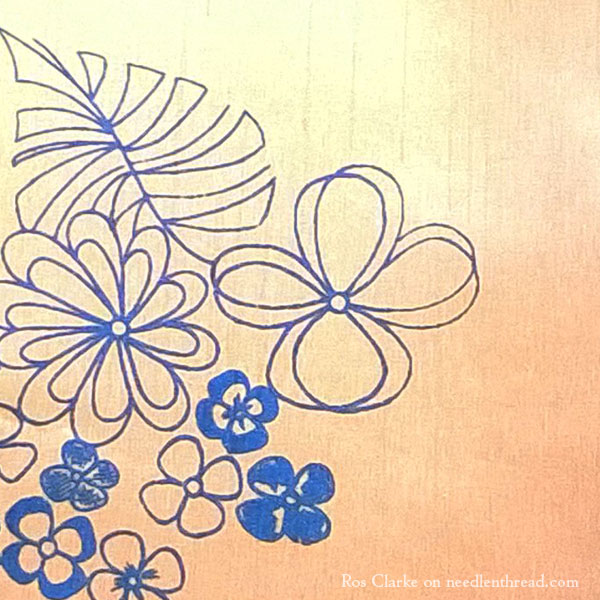
I love the idea of using screen printing for transferring embroidery designs. I hate tracing designs by hand and I find prick and pounce too much faff.
Obviously, it does cost money to get the screens made up, so it’s probably only worth it if you’re using the same design repeatedly – for kits, for classes, possibly for Christmas cards?! You only have to add a small amount of stitching if you want to, so I think this could actually work well for Christmas cards. The other possibility would be to find a friend who does screen printing and borrow their kit (or ask them to print it for you!)
Anyway, we’d all printed our designs, let the ink dry and ironed to fix it by coffee time.
So then it was time for stitching. The designs all use similar stitches, so we were all able to work them as Jen showed us how.
On the first day we did seeding, herringbone, French knots, stem stitch and Portuguese stem stitch. Of these, only Portuguese knotted stem stitch was new to me, but Jen’s demonstrations and tips improved my technique on all the others.
I found the Portuguese knotted stitch a nightmare to get right – I sneakily checked out Mary’s video of it in the evening, so I could have a better attempt at it.
The first day’s work was all on the green leaf:
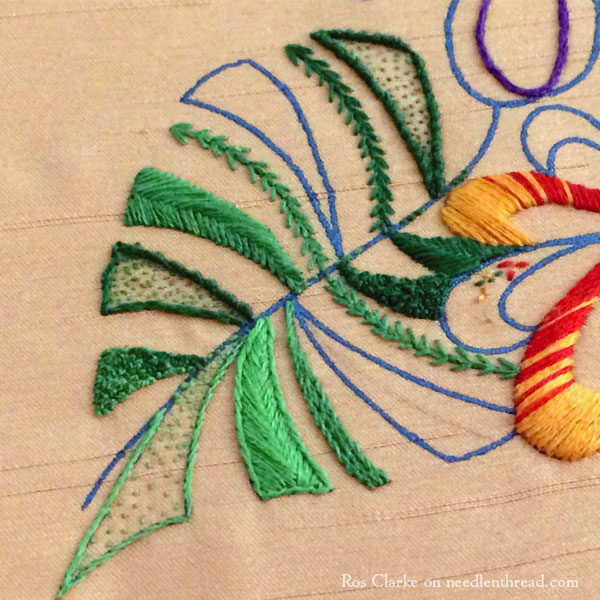
On day two we focussed on just two stitches: padded satin stitch and long and short stitch.
I’ve always struggled to produce satin stitch that I was happy with. Jen showed us how to do proper foundation stitching, as well as helping us to work a more consistent angle through a shape, and how to use multiple colours in an area of satin stitch.
Long and short stitch was the last thing we tackled. Jen helped us to choose colours which would shade well together, and then demonstrated how to work the stitch. She was particularly good at watching and correcting us all as we struggled with our long and short stitch flowers!
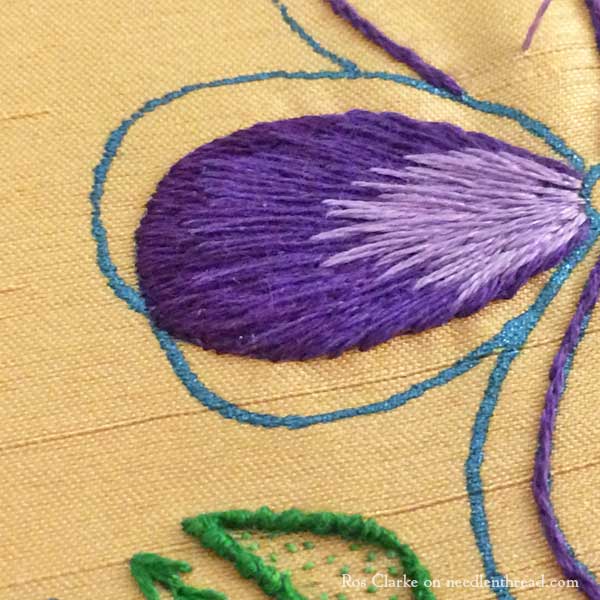
Finally, she made sure that we all had sufficient thread and beads to complete our kits at home, and demonstrated the last few stitches which add the small embellishments around the designs.
I particularly liked the fact that you didn’t need to bring any tools to the class. If you’re travelling – and one of the students was on a trip over from Canada – that can make a big difference. Everything was provided, including hoops, needles, threads and a comprehensive instruction booklet.
It wasn’t a beginner class, but I think we were all glad that she didn’t make any assumptions about what we already knew. The RSN’s ethos is all about passing on the traditional ways of stitching, so there are no short cuts here! In fact, we all said how helpful it was to be shown the right way of doing things, because our results were so much more satisfactory. When books, kits or classes simplify everything for beginners, their work will be disappointing and they’ll get frustrated and give up.
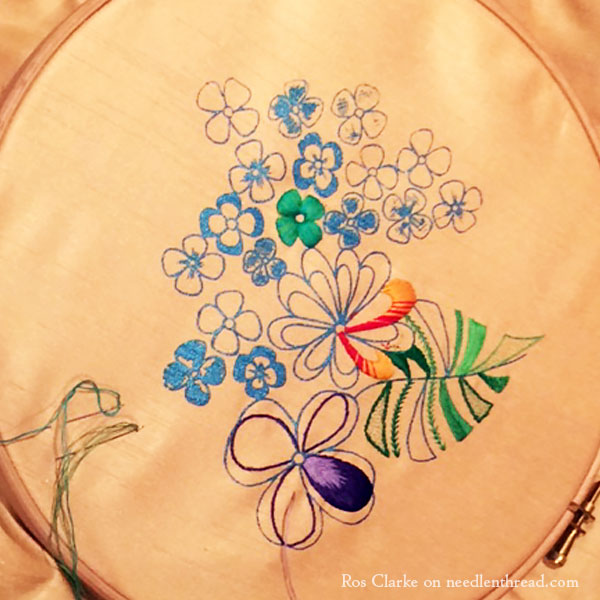
This is my work at the end of the two days.
As you see, I still have plenty to work on at home! But I’m glad to have a chance to keep practising what I learned in the class. And now I’m scanning the 2016 course list to see when I can sign up again!
Thanks heaps, Ros, for sharing your classroom experience at the RSN!
If you want more information about the Royal School of Needlework and the day classes they offer, hop on over to their website here. There’s a nice long list of all kinds of techniques available!







This was a great idea! And thank-you to your visitor for a full account.
Dear Mary
Great write up and lovely embroidery Ros. I went to the RSN a couple of years ago to view the Litany of Loreto and other embroideries it was really interesting. I will look at there courses as I liked it there and of course the icing on the cake is Hampton Court. They sound like great courses and as you said you learn a lot. Thanks Mary for sharing Ros’s experience at the RSN and thank you Ros for inspiring with the courses at the RSN.
Regards Anita Simmance
Thanks for hosting me today, Mary. It was fun to think about the class again and share it with your readers. I know that the RSN do run some day classes in the US so you don’t all have to travel here to enjoy their teaching.
And I forgot to include three tips from the class that I thought were worth passing on:
1. A plastic shower cap makes an excellent cover for work on an embroidery hoop while you’re not using it and you can store your threads etc in it too.
2. Long and short stitch would be better named ‘Long and longer stitch’ – it looks much better when you don’t make your stitches too short.
3. NO STROKING! I’m terrible at this. I want to stroke my work all the time, but it does make the thread fuzzy and compromise the work long term.
Many thanks, Ros, for writing about the class, it was fascinating. Love the shower cap idea – would never have thought of that!
It was good to read about the RSN, I live quite near it, but the classes, which I’m afraid as a pensioner I find rather expensive, but putting that aside, all the beginners classes, whites where I would be happy areallthoroughly booked! I suppose that is success, but a bit disappointing for some of us wishing to return to some teaching. Thank you Mary for your daily bulletin, it is heartwarming, informative and encouraging.
They are quite expensive but I think they are worth it. The 2016 courses have recently been announced so it might be worth checking again if there are spaces – perhaps you could have it as a special Christmas or birthday treat?
Thoroughly enjoyed this — felt like I was there! Thanks to both Ros and Mary.
I also had a wonderful experience this summer taking two RSN classes. (By the way, I found out about RSN classes via this website.) While I have some embroidery experience, I still earned my money’s worth through Introduction to Embroidery and Introduction to Crewel Embroidery, both of which provided me many new tips and techniques. The classrooms are lovely with big windows flooding the rooms with natural light. One of the things I’ll remember most was the sight of clean, orderly classrooms outfitted with long tables that were lined with our embroidery hoops and beautiful bags that contained our class kits. The RSN shop was also a wonderful treat. In addition to a couple of books and some hoops, I purchased three beautiful hand-embroidered broaches. (Tip: If you plan on visiting the shop, you might want to join RSN via the internet to take advantage of a nice shop discount.) (Another tip: If you’re interested in quilting, there is a cute little shop within walking distance in the little village just outside Hampton Court.) One thing that I wish I’d planned better was how to get there from the London apartment where we stayed. We discovered that the quickest way to get to Hampton Court was to catch a train from Waterloo station. The train stopped within a block of the palace. I can’t wait for my next opportunity to take more RSN classes!
I booked an AirBnB room within walking distance of the palace, which was lovely, very affordable, and had easy parking. I walked past that little quilt shop every day but never at a time when it was open!
Thankyou for this write up, it was lovely to read and the pictures are beautiful. I would love the chance to take a class at the RSN.
Thanks for sharing this. Taking a class at the RSN is a dream of mine. I didn’t realize it was in such lovely surroundings.
Oh how fun! I really enjoyed reading about Ros’ adventure and seeing the lovely pictures of embroidery and the castle. The screen printing idea sounds like it would be fun to do and very interesting to see first hand.
Bravo on sharing the experience with everyone.
Thank you for such a woncerful review of your class. I so wish I could take such a class.
Thank you Mary and Ros for the opportunity to share your class experiences. Loved the article and the photos, what a joy to be in a class at The RSN, won’t happen for me but this is almost as good.
Would love to read more about classes from those who have been, doesn’t need to be at this wonderful venue, just sharing is a delight.
What a beautiful place to stitch. I love the embroidered piece you worked on. What an honor to be able to take a class at the RSN.